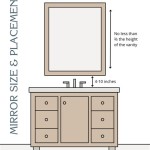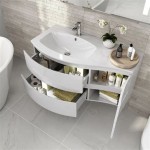How To Install a Broan Bathroom Exhaust Fan
Installing a Broan bathroom exhaust fan is a valuable home improvement project that can significantly enhance the air quality and overall comfort of a bathroom. A properly installed exhaust fan effectively removes moisture, odors, and pollutants, preventing mold growth and improving ventilation. This article provides a comprehensive guide for installing a Broan bathroom exhaust fan, covering essential preparations, step-by-step instructions, and crucial safety considerations.
Before undertaking the installation, it is imperative to understand the scope of the project and assess existing conditions. This assessment includes determining the required fan size and capacity, evaluating the existing wiring, and identifying the proper venting pathway. Careful planning and preparation are critical for a successful and safe installation.
Key Point 1: Preparation and Safety Precautions
Prior to commencing the installation process, meticulous preparation is paramount. This stage not only ensures a smoother workflow but also prioritizes safety. Begin by assembling all necessary tools and materials. These typically include a Broan bathroom exhaust fan kit, drill, screwdriver, wire strippers, wire connectors, measuring tape, pencil, drywall saw (or utility knife), safety glasses, gloves, a ladder, and potentially a stud finder.
Safety is of utmost importance. Before working with any electrical components, disconnect the power supply to the bathroom circuit at the main electrical panel. Verify that the power is disconnected using a non-contact voltage tester. This step is non-negotiable and crucial for preventing electrical shock. Furthermore, wearing safety glasses and gloves provides additional protection during the installation process.
Carefully read the Broan exhaust fan installation manual that comes with the unit. Each model may have specific instructions and requirements that deviate slightly from general guidelines. Understanding the manufacturer's recommendations is essential for proper installation and optimal performance.
Inspect the area where the fan will be installed. Ensure there is adequate space for the fan housing and ductwork. Determine the best venting route, considering factors such as attic access, proximity to an exterior wall or roof, and the presence of any obstructions. Planning the venting pathway in advance will save time and prevent complications during the installation.
Confirm that the existing wiring is adequate for the new fan. Check the voltage and amperage requirements of the fan and compare them to the existing circuit. If the wiring is insufficient, consult with a qualified electrician to upgrade the circuit or install a dedicated circuit for the fan.
If replacing an existing fan, carefully remove the old unit. Disconnect the wiring and detach the fan housing from the ceiling. Clean the area and repair any damage to the ceiling before proceeding with the new installation.
Key Point 2: Installation Procedure
The installation procedure can be broken down into several key steps, each requiring careful attention to detail. First, mark the location of the fan housing on the ceiling. Use the fan housing as a template to trace the outline of the opening onto the ceiling. Ensure that the opening is large enough to accommodate the fan housing but not so large that it creates gaps around the edges.
Using a drywall saw or utility knife, carefully cut along the marked outline to create the opening for the fan housing. Exercise caution to avoid damaging any electrical wiring or plumbing that may be concealed within the ceiling. Once the opening is complete, test-fit the fan housing to ensure it fits snugly and securely.
Install the ductwork. Connect the duct adapter to the fan housing and attach the duct to the adapter. Secure the duct connections with foil tape or clamps to prevent air leaks. Route the ductwork to the exterior vent, ensuring that it follows a straight path and avoids sharp bends. Insulation may be necessary for the ductwork to avoid condensation forming inside the duct.
Position the fan housing within the ceiling opening and secure it to the ceiling joists using screws or mounting brackets. Ensure that the housing is level and stable. If necessary, use shims to compensate for any irregularities in the ceiling surface.
Connect the electrical wiring. Carefully strip the ends of the wires and connect them to the corresponding terminals on the fan housing, following the wiring diagram provided in the installation manual. Use wire connectors to secure the connections and ensure that they are properly insulated. Double-check the wiring connections to prevent shorts or other electrical problems.
Attach the fan motor and grille to the fan housing. Follow the manufacturer's instructions for attaching these components. Ensure that the fan blades are properly aligned and that the grille is securely fastened to the housing.
Key Point 3: Venting the Exhaust Fan
Proper venting is critical for the effective operation of a bathroom exhaust fan. The primary purpose of the fan is to remove moist air from the bathroom and exhaust it to the exterior of the house. Improper venting can lead to moisture buildup, mold growth, and reduced fan performance.
The ideal venting location is through the roof or an exterior wall. Avoid venting the exhaust fan into the attic, as this can lead to moisture accumulation and potential damage to the attic structure. Always vent to the outside of the house.
Use rigid metal ductwork whenever possible. Rigid ductwork provides better airflow and is less prone to kinking or collapsing than flexible ductwork. If flexible ductwork is necessary, use a high-quality insulated duct to prevent condensation.
Ensure that the ductwork is properly insulated. Insulation will help to prevent condensation from forming inside the duct and dripping back into the bathroom. Use fiberglass or foam insulation to wrap the ductwork, paying particular attention to joints and seams.
Install a proper exterior vent cap. The vent cap should have a damper that opens when the fan is running and closes when the fan is off. This will prevent outside air from entering the ductwork and prevent pests from nesting inside.
Consider the length and number of bends in the ductwork. Longer duct runs and multiple bends will reduce the airflow of the fan. If the duct run is long or has several bends, consider using a more powerful fan to compensate for the reduced airflow.
Inspect the ductwork regularly to ensure that it is clean and free of obstructions. Dust, lint, and other debris can accumulate in the ductwork and reduce the fan's efficiency. Clean the ductwork periodically to maintain optimal performance.
After completing the installation, thoroughly test the exhaust fan. Turn on the power to the circuit and activate the fan. Verify that the fan is running smoothly and that air is being exhausted to the exterior. Check for any air leaks around the fan housing or ductwork. If any issues are detected, troubleshoot the installation and make any necessary adjustments.
Once the installation is complete, keep the installation manual in a safe place for future reference. The manual contains important information about the fan's operation, maintenance, and troubleshooting. Familiarize yourself with the manual and follow the manufacturer's recommendations to ensure the fan operates safely and effectively for years to come.
Finally, be aware of local building codes and regulations pertaining to bathroom exhaust fan installation. Contact your local building department to determine if any permits are required for the installation. Adhering to local codes ensures compliance and prevents potential problems down the road.

Broan Nutone Invent Bath Fan Installation

Remove Install A Bathroom Fan Grille In 1 Min

Broan Nutone Easy To Install 80 Cfm Bathroom Exhaust Fan With Led Clean Cover Energy Star Aern80lk The Home Depot

How To Clean Replace Light Broan Model 678 Exhaust Fan

Broan Nutone 110 Cfm Bathroom Exhaust Fan With Cct Led Light Cleancover Grille Energy Star Aer110cctk The Home Depot

How To Install A Bathroom Exhaust Fan Broan 688

What You Need To Know About Installing A Broan Nutone Exhaust Fan Williams

Broan Nutone Flex Series 110 Cfm Ceiling Mounted Room Side Installation Bathroom Exhaust Fan With Light A110l The Home Depot

How To Replace A Bathroom Ceiling Fan Broan 671 Easy And Simple Tutorial

Broan Nutone Part Qk60s 60 Cfm Quick Install Bathroom Exhaust Fan Motor And Grille Upgrade Kit Accessories Home Depot Pro
Related Posts







